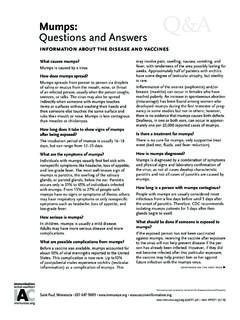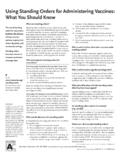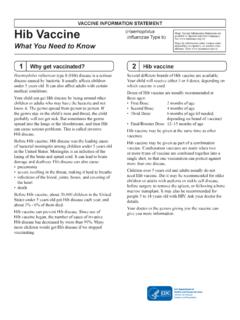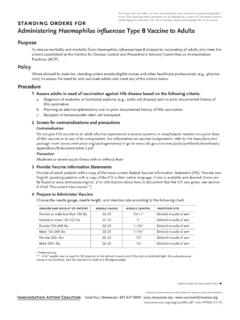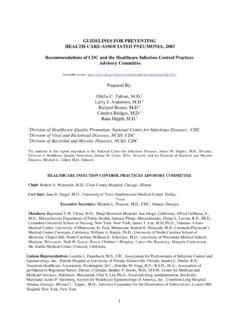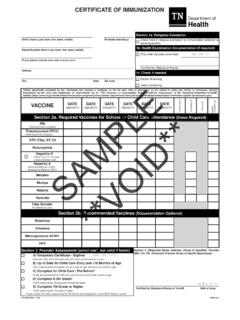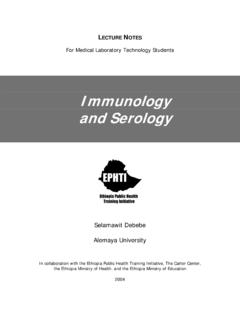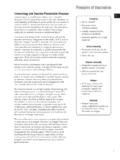Transcription of Tetanus: Questions and Answers
1 Saint Paul, Minnesota 651-6 47-9009 Item #P4220 (6/20)What causes tetanus?Tetanus is caused by a toxin (poison) produced by the bacterium Clostridium tetani. The C. tetani bacteria cannot grow in the presence of oxygen. They produce spores that are very difficult to kill as they are resistant to heat and many chemical does tetanus spread?C. tetani spores can be found in the soil and in the intestines and feces of many household and farm animals and humans. The bacteria usually enter the human body through a puncture (in the presence of anaerobic [low oxygen] conditions, the spores will ger-minate).Tetanus is not spread from person to long does it take to show signs of tetanus after being exposed?
2 The incubation period varies from 3 21 days, with an average of eight days. The further the injury site is from the central nervous system, the longer the incubation period. The shorter the incubation period, the higher the risk of are the symptoms of tetanus?The symptoms of tetanus are caused by the tetanus toxin acting on the central nervous system. In the most common form of tetanus, the first sign is spasm of the jaw muscles, followed by stiffness of the neck, difficulty in swallowing, and stiffness of the abdominal signs include fever, sweating, elevated blood pressure, and rapid heart rate. Spasms often occur, which may last for several minutes and continue for 3 4 weeks.
3 Complete recovery, if it occurs, may take serious is tetanus?Tetanus has a high fatality rate. In recent years, tetanus has been fatal in about 10% to 20% of reported cases. What are possible complications from tetanus?Laryngospasm (spasm of the vocal cords) is a com-plication that can lead to interference with breathing. Patients can also break their spine or long bones from convulsions. Other possible complications include hypertension, abnormal heart rhythm, and secondary infections, which are common because of prolonged hospital , the high probability of death is a major is tetanus diagnosed?The diagnosis of tetanus is based on the clinical signs and symptoms only.
4 Laboratory diagnosis is not useful as the C. tetani bacteria usually cannot be recovered from the wound of an individual who has tetanus, and conversely, can be isolated from the skin of an indi-vidual who does not have kind of injuries might allow tetanus to enter the body?Tetanus bacilli live in the soil, so the most dangerous kind of injury involves possible contamination with dirt, animal feces, and manure. Although we have tradi-tionally worried about deep puncture wounds, in reality many types of injuries can allow tetanus bacilli to enter the body. In recent years, a higher proportion of cases had minor wounds than had major ones, probably because severe wounds were more likely to be properly managed.
5 People can also get tetanus from splinters, self-piercing, and self-tattooing. Injecting drug users are also at risk for stepped on a nail in our yard. What should I do?Any wound that may involve contamination with teta-nus bacilli should be attended to as soon as possible. Treatment depends on your vaccination status and the nature of the wound. In all cases, the wound should be thoroughly cleaned. Seek medical treatment immedi-ately and bring your immunization record with wounds that involve the possibility of tetanus contamination, a patient with an unknown or incom-plete history of tetanus vaccination needs a tetanus- and diphtheria-containing shot (Td or Tdap) and a dose of tetanus immune globulin (TIG) as soon as : Questions and Answersinformation about the disease and vaccinescontinued on the next page A person with a documented series of three tetanus- and diphtheria-containing shots (Td or Tdap) who has received a booster dose within the last ten years should be protected.
6 However, to ensure adequate protection, a booster dose of vaccine may still be given if it has been more than five years since the last dose and the wound is other than clean and there a treatment for tetanus?There is no "cure" for tetanus once a person develops symptoms, just supportive treatment and manage-ment of complications. The best "treatment" is preven-tion through common is tetanus in the United States?Tetanus first became a reportable disease in the late 1940s. At that time, there were 500 600 cases reported per year. After the introduction of the tetanus vaccine in the mid-1940s, reported cases of tetanus dropped 2016 through 2018, an average of 30 cases were reported per year.
7 Almost all cases of tetanus are in people who have never been vaccinated, or who completed their child-hood series, but did not have a booster dose in the preceding 10 is neonatal tetanus?Neonatal tetanus is a form of tetanus that occurs in newborn infants, most often through the use of an unsterile cutting instrument on the unhealed umbilical stump. These babies usually have no temporary immu-nity passed on from their mother because their mother usually hasn't been vaccinated and therefore has no tetanus is very rare in the United States (only 3 cases were reported from 2001 through 2016), but is common in some developing countries.
8 Can you get tetanus more than once?Yes! Tetanus disease does not result in immunity because so little of the potent toxin is required to cause the disease. People recovering from tetanus should begin or complete the vaccination did vaccine first become available for diph-theria, tetanus, and pertussis?The first inactivated toxin, or toxoid , against diphtheria was developed around 1921, but it was not widely used until the 1930s. In 1924, the first tetanus toxoid (inac-tivated toxin) was produced and was used successfully to prevent tetanus in the armed services during World War II. The first pertussis vaccine was developed in the 1930s and was in widespread use by the mid-1940s, when pertussis vaccine was combined with diphtheria and tetanus toxoids to make the combination DTP vac-cine.
9 A series of 4 doses of whole-cell DTP vaccine was quite (70 90%) effective in preventing serious pertus-sis disease; however, up to half of the children who received the vaccine developed local reactions such as redness, swelling, and pain at the injection site. In 1991, concerns about safety led to the development of more purified (acellular) pertussis vaccines that are associated with fewer side effects. These acellular per-tussis vaccines have replaced the whole cell DTP vac-cines in the In 2005, two new vaccine products were licensed for use in adolescents and adults that combine the tetanus and diphtheria toxoids with acellular pertussis (Tdap) vaccine.
10 These vaccines are the first acellular pertussis-containing vaccines that make it possible to vaccinate adolescents and adults against are vaccines made that prevent diphtheria, tetanus and pertussis?These vaccines are made by chemically treating the diphtheria, tetanus, and pertussis toxins to render them nontoxic yet still capable of eliciting an immune response in the vaccinated person. They are known as inactivated vaccines because they do not contain live bacteria and cannot replicate themselves, which is why multiple doses are needed to produce s the difference between all the vaccines containing diphtheria and tetanus toxoids and pertussis vaccine?


